NEW YORK TIMES: A national election is a giant pop-up event, larger in scale and significance than any other private or public occasion. Two-thirds of Americans expect the Covid-19 outbreak to disrupt voting in November, according to a late-April survey by the Pew Research Center. A successful election will require some Covid-era changes. The main one is enabling tens of millions more people to vote by mail (also called absentee balloting — the terms are synonymous) than have ever done so before. It’s also important to make adjustments to keep polling places open for people who don’t have stable mailing addresses — a group that increases as people are uprooted during an economic downturn — or whose disabilities, like blindness, make it hard to fill out a ballot unassisted.
The outcome of the presidential contest will most likely be decided in a handful of swing states. This year, the likeliest prospects are Wisconsin, Michigan, Pennsylvania, Florida, North Carolina and Arizona. All of them, along with 23 other states and the District of Columbia, already have laws on the books that give voters the right to request an absentee ballot without an excuse. But only one swing state is already set up for most people to vote by mail — Arizona, where 79 percent did so in 2018. In Florida and Michigan, about 25 to 30 percent voted by mail that year. In Wisconsin, Pennsylvania and North Carolina, very few voters have voted absentee in a general election; in 2018, the range was from 3 to 6 percent, according to The Brennan Center for Justice at New York University Law School. (A total of 27 states fell below 10 percent, including Georgia and New Hampshire, which also may see close presidential results.)
To fundamentally change the way voting has been done in those states, they will have to move quickly to sign contracts with vendors and then order supplies, like specially certified paper for envelopes and ballots, high-speed scanners to count votes and secure drop-off boxes. If they wait, they’ll risk running into shortages like the ones that have troubled the country’s efforts to fight the virus. In Wisconsin in April, when voting by mail rose to more than 70 percent, totaling over a million, from around 6 percent in previous elections, many people didn’t get to vote because counties ran out of envelopes for a time and then couldn’t fill all the applications for absentee ballots fast enough. “Wisconsin shows that you can’t adopt vote-by-mail overnight,” says Nathaniel Persily, a Stanford law professor and the head of the Healthy Elections Project, a new effort by Stanford and the Massachusetts Institute of Technology to address the threat of Covid-19. “It’s not as easy as people think. The boring stuff matters — the scut work of supply chain and logistics and management is crucial.” MORE
FRESH AIR: Assuming the pandemic has not ended by Election Day, will you be able to vote by mail? And if not, are you willing to risk your health, maybe your life, by going to the polls in order to exercise your constitutional right to vote, like many people in the Wisconsin primary did last month? My guest Emily Bazelon has written a new article titled “Will Americans Lose Their Right To Vote In The Pandemic?” It’s published in this week’s edition of The New York Times Magazine. She focuses on many of the financial and political obstacles that are likely to prevent many Americans from voting by mail. She writes, the U.S. prides itself on its democracy in theory, but this year, not necessarily in practice. Bazelon is a staff writer for The New York Times Magazine, where she writes about legal issues. And she’s the Truman Capote Fellow for creative writing and law at Yale Law School. Her latest book, “Charged: The New Movement To Transform American Prosecution And End Mass Incarceration,” was just published in paperback. It won the 2020 LA Times Book Prize in the current interest category. MORE

